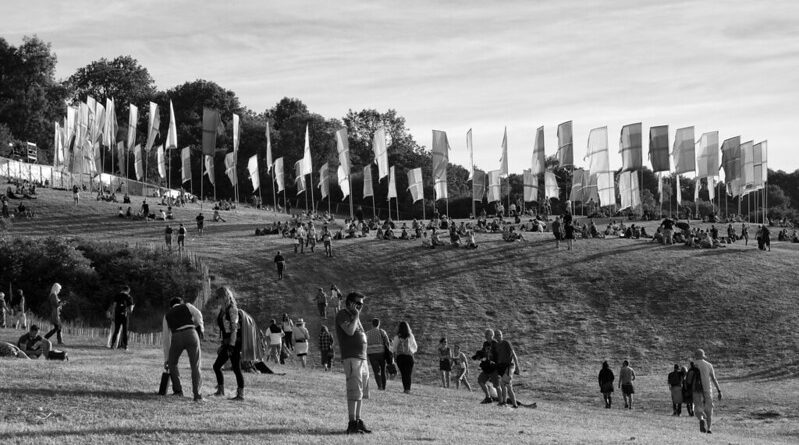Glastonbury Festival
Festival Essentials
Where: Worthy Farm, Pilton, Vale of Avalon, Somerset, Southwest England
When: Mid-June
What happens: World’s largest outdoor music festival – a riotous jamboree of bands, theatre, healing and performing arts
Remember to bring: Bin bags, loo roll and a wide open mind which you’re sure to lose in another dimension!
Where it’s at
If you are going to an English music festival then without doubt it has to be Glastonbury – it’s the oldest, it’s the biggest, it’s a world within a world and it is the one that everyone goes to.
Glastonbury is the largest outdoors festival of music and performing arts in the world which each year hosts some of the biggest and best artists in the world.
Located in the Southwestern county of Somerset on a giant 900-acre farm site in the Vale of Avalon, a place of ancient myths and Kind Arthur legends, festival goers here can expect enlightenment, rude awakenings, bizarre happenings, and moments which border on other-worldly.
The festival usually takes place on the second or third weekend in June, after the Summer Solstice. The site generally opens on the Wednesday of the festival with impromptu music happening each night until the festival starts proper on the Friday, running through until the Sunday.
Past festival artists
Everyone who is anyone has performed here at some stage in their career: past acts include Marc Bolan, David Bowie, New Order, The Smiths, Elvis Costello, PJ Harvey, Velvet Underground, Radiohead, Robbie Williams, Oasis, The Rolling Stones, Jay-Z, Dolly Parton, the list goes on and on!
Glastonbury culture
Some people say it’s become too mainstream and crowded since the 1990s, with ticket prices soaring through the roof every year and old school acts like Rod Stewart and Paul McCartney headlining the main stages, but there’s something for everyone at this massive event which turns a large dairy farm into a makeshift city composed of every sub-culture under the sun. Expect all sorts at the festival – dreadlocked hippies, ravers, celebrities in green wellies, new age travelers, musicians, thespians, and families soaking up the crazy atmosphere. Glastonbury gives you a once-in-a-lifetime chance to experience all the genres of music, people, styles, tastes and sounds that Europe has to offer – and you’ll definitely have a wild time in the bargain. A dull moment at Glastonbury is unimaginable.
Getting a ticket for Glastonbury Festival
A ticket to the festival is like gold dust; the 100,000-plus tickets usually sell out within a few hours. Since the organizers have put the clamps on the great fence-hopping traditions of yesteryears, you will need to purchase one, retailing at over $200, if you want to get in. Be warned that tickets usually sell out within a few hours of going on sale, so check the website for details of the release date and take the morning off work to sit by the phone.
History of Glastonbury Festival
Glastonbury is one of the original music festivals. First held during the long hot summer of 1970, the day after Jimi Hendrix died, it was the perfect hippie retreat. It was all about celebrating great music, groovy dancing and having a good time, with a bunch of other folk. The original festival was by donation of a mere £1 (under $2) which included free milk – as the festival is still held today on the site of Worthy Farm, a working dairy farm owned by Britain’s hippest farmer, Michael Eavis. Despite the steep admission charges today, profits do go to good causes – in particular Greenpeace (who sponsor the main Pyramid Stage), Oxfam, Water Aid, and other humanitarian charities.
Getting to the festival site
The festival site is three miles from the nearest town of Shepton Mallet, and six miles from the next major town of Glastonbury. The nearest major city is Bristol. Castle Cary is the nearest train station, from which you can get a free festival shuttle bus, or National Express operate cheap direct coaches to the site from all major cities. Expect big crowds and traffic jams all the way, sometimes trailing back for up to six hours, on the legendary 303 B-road approaching the site, which was even iconicised in a song by former-festival headline act Kula Shaker.
Where to stay
Accommodation is strictly a camping affair. If you want to go up-market you can rent a trailer for about $1,000 for the weekend, or you could make like an Indian and hire a tipi to stay in the Tipi Field but this must be organized in advance.
You’ll make plenty of friends during your long weekend – and you’ll probably get to known your camping neighbor more intimately in three days than your real-life neighbors in three years, so get there early to get a good spot and families may want to avoid pitching next to big groups.
Festival entertainment
There is so much to do here, and the site is massive so you’ll have to work out how to navigate around on your first day. The main areas are:
Main Stages
There are six main stages hosting mainly established artists – the largest of which is the Pyramid Stage, followed by the Other Stage, with the Dance Village, Jazz World, Acoustic Tent, New Band Stage (re-christened the John Peel Stage in 2005 after the death of the great alternative music DJ in 2004), and Fields of Avalon offering more low-key specialist alternatives.
Circus and Theatre
A wild space packed full of fire jugglers, big top acrobats, comedians, cabaret singers, and poets, with everything from family-friendly theatre in the day through to adults-only acts like the Jim Rose Circus late at night. Or the Lost Vagueness crew further out of the site near the Stone Circle has nuns and vicars conducting mock mass weddings, or you can don a mud-caked dinner jacket and head to the casino for gambling, burlesque cabaret, and swing bands. There is no avoiding theatre at Glastonbury as many mix-and-mingle performance artists – some booked but some impromptu – fill the festival with crazy costumes, inventions, and props making for some unexpected encounters.
Green Fields
This large area is set aside for alternative medicine, healing, environmentally-friendly technology, crafts, and social debates. It’s the perfect place to begin a shamanic journey, enjoy a sauna (there are few public showers on site!), chill out, or see really far-out bands – where the generators are often powered by pedal bike! There’s also entertainment here for kids and the Tipi Field.
King’s Meadow
At the top of the Green Fields is the King’s Meadow with the Sacred Space which offers fantastic views across the whole festival site, a stone dragon, and a stone circle – built in 1990 AD! At night, fires and torch lights illuminate the circle and the sound of a thousand-and-one djembe drummers beating in (near) unison fills the air. It’s the space for your spiritual encounter, or just a chance to get ‘stoned with the stones, man!’
Festival tips
– Run out of food or money? Head to the tent of the orange-robed Hare Krishna, a sect of Hinduism, for free nourishment for the stomach and soul to the prayer chant of: ‘Hare Krishna Krishna Krishna, Krishna Krishna, Hare Rama…’
– You can get every drug imaginable here, with many dealers openly touting their wares with cries of: ‘Acid! E! Speed! Hash for cash!’ Smoking hash is usually tolerated by festival police but even if you don’t get ripped off by the fly-by-night dealers you may end up with something you didn’t expect, so these crooks are best avoided and keep an eye on you minors at all times.
– Crime is rife at the festival, a space with a population the same as the nearby city of Bristol. Don’t leave anything of any value in your tent and don’t bring anything you can’t afford to lose or get trashed. There are cash points on site, but expect long queues and transaction charges. Even tent theft – where someone brings a large tent to ‘eat’ up a smaller tent and dispose of its contents – is a bizarre but common occurrence. Gun and violent crime was a problem in previous years but has largely been dealt.
– Bring plastic bin liners, they are essential for everything from emergency waterproofs to makeshift volleyballs. Earplugs are a festival-goer’s essential. Wear them in the rave tent and your ears won’t ring in the morning, or wear them in bed and you’ve got an outside chance of getting some sleep.
– Glastonbury’s toilets are notorious. Toilet facilities per head are limited, and they are usually stinking by the end of day one. Bring your own toilet roll. There are a few flushing loos on site so suss out their locations and use every time you pass through. Also, if you see the van that cleans out the toilets passing by, take this as a chance to get in while it’s moderately clean. There are few showers on site: expected to get sweaty, dirty, and stink by the end. The service stations on the nearest stretch of motorway to the site are another notorious post-festival gathering for scraping off the mud, washing, and three days of suppressed bowel relief.
– Despite the festival taking place in British summertime, the weather can be unpredictable and torrential in the West of England and some of the Glastonbury Festivals in recent years have been totally washed out, with rain halting play on the main stages, tents washed into a field of mud, and out-of-it punters swilling in the mud like pigs! Because of the isolated location of the site, and the vast numbers of people churning up the grass lands, even a slight rain shower can turn the grounds boggy, so if you like things calm and clean this is not the festival for you. Bring wet weather gear, a pair of good old British wellington boots, and check the forecast in advance. Or how about a shower curtain: take it to the festival and voila – an instant waterproof rug, rain coat, an extra blanket and something to lay over your tent if it starts to leak!
– On site costs for drink, food, and essentials like lighters, toilet rolls, or an umbrella are all available, but if you want to save cash it’s best to bring your own where possible. There are plenty of international cuisines to experiment with like Creole, Chinese, Lebanese, and lots of veggie and vegan options so dig in.
– Now where did I pitch my tent? In the dark, your cheapo identikit tent could look remarkably similar to the other 70,000 or so. Get there early and pitch up near a recognisable landmark – and mark your tent with paint or a flag – glow-in-the-dark accessories will help you see your way home. Likewise, a torch will come in handy.
– Unless you want to become a Glastonbury Festival cliché, avoid buying a jester’s hat. You may as well have a sign saying ‘naïve festival virgin’ over your head. There are plenty of better buys at the hundreds of festival stall like new age jewellery, crafts, ethnic clothes, CDs, posters – all the hippy chic you can imagine and at competitive prices.
– Get a festival program before the first day of music and plan your schedule if you want to catch certain bands. The trek from one end of the site to the other can take over an hour to negotiate the paths and crowds. On the other hand, there are plenty of smaller stages towards the south side of the sight which are great to meander around, seeing what new talents you may discover. Many people come here and have a great time without once seeing a band on the main stages, just soaking up the atmosphere, chatting, and exploring the alternative elements of this mini-city.
Other things to see and do
Visit Glastonbury
Glastonbury town and the surrounding region is the undisputed centre of spiritual England and is considered one of the oldest religious sites in the country. Pagan and Christian pilgrims have flocked to Glastonbury for centuries and even today it’s frequented by spiritual tourists and new age travelers. The town has plenty of new age shops to explore and find something that calls to you.
Glastonbury Tor is a small 500-foot hill, at the summit of which stands the remains of the Medieval Church of St Michael. The last Abbot of Glastonbury was executed on the Tor by Henry VIII, but these days it’s a great place from which to look out at the scenic surrounding countryside. Glastonbury Tor is open to visitors throughout the year, and it takes just 25 minutes to climb to the summit. You can survey the countryside for mile around and inspect the intricate carvings of St Michael at the base of the tower.
Natural springs
White Spring is a natural water source, which flows into a cavern at the foot of Glastonbury Tor. It’s an ideal spot to take in the atmospheric surroundings and refreshments are available at the café here. Chalice Well on Chilkwell Street in the town has long been associated with powers of healing, for those who sip the water which cascades through the Lion’s Head spout.
Glastonbury Abbey
The first evidence of a church on the site of Glastonbury Abbey dates back to the seventh century, when King Ine ordered that a monastery be built here. The original church was destroyed in a fire in 1184, and the Abbey was rebuilt in the reign of King Henry II. In 1191, after several monks claimed to have had visions that King Arthur was buried in the grounds of the Abbey, excavations uncovered their alleged tombs. The regal pair were re-interred before the high altar in 1278, but with the dissolution of the monasteries by King Henry VIII in 1539, all traces of the tomb disappeared and the Abbey itself fell to ruin. The ruins of Glastonbury Abbey are open daily, and you can still see the Lady Chapel, the Abbot’s Kitchen and the supposed spot where Arthur and Guinevere were buried.
MORE INFORMATION
Glastonbury Festival Official Website
For ticket info, history of the festival, and information on all aspects of the festival experience.
BBC Music: Glastonbury 2015
Information on the live music and TV coverage of the event.
The Big Green Gathering
Separate festival which takes place in Cheddar, Somerset in August, at which many of Glastonbury’s Green Fields crowds perform and attend.
Lost Vagueness
Insane burlesque events and an annual summer festival organized by Glastonbury eccentrics: expect group weddings, a legendary casino, and ultimate 1930s glamour.
Update! Lost Vaguness is no more! But instead there are a series of mind blowing areas to discover such as The Rabbit Hole and Shangri-La to name but a few…
By Susi O’Neill
Image Credits:
C/C via Flickr rjshade
Avalon C/C Chris Lee
Photo: C/C Ian Tyas/Keystone Features/Getty Image
The Tipi Field: C/C jaswooduk
courtesy of Glastonbury official
Hare Krishna C/C SusieWoo
C/C unknown
Glastonbury Tor: C/C Sue Mosher




